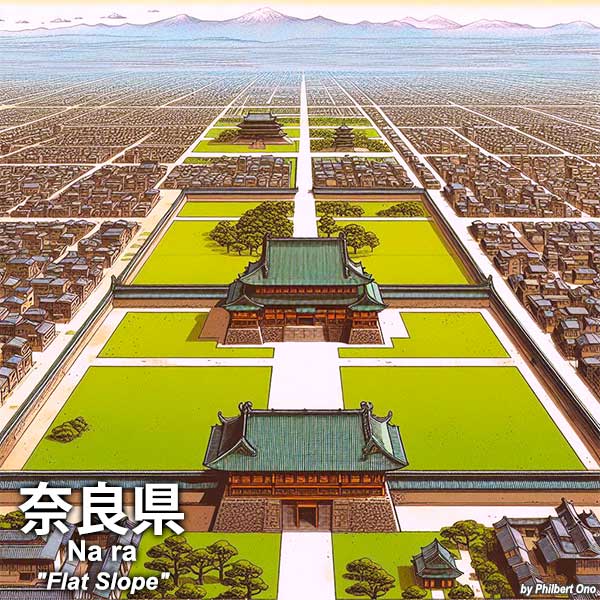NARA – Flat Slope 奈良県

The “Nara” place name has been around since ancient times and can be found in most all historical Japanese texts including the Kojiki, Nihon Shoki, and Man’yoshu anthology of poems.
However, a plethora of kanji characters for “Nara” have been used over the centuries until the current kanji characters (奈良) were officially set. They include 那羅, 平城, 寧楽, 乃楽, 名良, 奈羅, 平, 常, and 寧楽. The are all pronounced “Nara.”
The meaning of most of these kanji characters refers to a flat, gently sloping land. It’s where the capital, palaces, and population were concentrated.
There are a number of theories on the origin of the Nara name. The 8th century Nihon Shoki has a passage mentioning “fumi-nara” (蹢跙 or 布瀰那羅須), referring to soldiers trampling on the woods on a mountain which was named “Mt. Nara” as a result of the trampling. This is the oldest known mention of the name, but since it is a common story for place name origins, experts don’t really think it applies to Nara.
Researchers instead believe the most plausible origin is the one presented by Yanagita Kunio (1875–1962), a Japanese scholar and folklorist. He believes it means “flattened land” (平(なら)した地).
In his research of place names, he found that different words were used in different regions to refer to land gently sloping from the mountains. In eastern Japan, it is called tahira (平). In southern Kyushu, hae.
In western Japan and Shikoku, it’s naru. Naru may have morphed into narasu (verb meaning “to flatten”) or narashi (adverb meaning “flat”) or narushi (adjective meaning “flat”). The kanji character or radical 平 is usually included. This indicates the “flat” meaning.
Since it is known that Nara’s former name was “Heijo” (平城) (flat castle), the “flat” meaning seems to have the most credence.
A less accepted theory is by Yoshida Togo (吉田東伍 1864–1918), a geographer and place name researcher, who thought “Nara” referred to the nara oak tree (楢) mentioned in the Man’yoshu anthology of poems.
Landlocked on the Kii Peninsula, Nara Prefecture indeed has a large, flat plain named the Nara Basin (奈良盆地) or Yamato Plain (大和平野) in the northern half which includes the Yamato Highlands (大和高原). Nara’s major cities are in the northern half.
Meanwhile, the southern half is mountainous with the Kii and Yoshino Mountains. This part can be called the “Roof of the Kinki Region.” Although Nara is the eighth largest prefecture by land area, only 23 percent of its land area is habitable by humans, among the smallest percentage in Japan.
Being the former Imperial capital multiple times during the 4th to 8th centuries, Nara is one of Japan’s most historic places. The Nara Period (710–794) is named after this city and prefecture.
It was during the Nara Period when the monumental Kojiki and Nihon Shoki national histories and mythology and the Man’yoshu poetry anthology were compiled. Buddhism also started to spread from Nara after Emperor Shomu embraced it. The great Todaiji Temple with the giant Buddha statue was also built in Nara during this time.
After the Imperial capital moved to Kyoto (Heiankyo), Nara was called Nanto (南都 Southern Capital) or Heijokyo (平城京 Flat Castle Capital).
Old province name: Yamato-no-Kuni (大和国)
*The AI-generated image is for illustrative purposes only and may not accurately depict any particular place in the prefecture.
Sources: https://ja.wikipedia.org/wiki/%E5%A5%88%E8%89%AF
https://en.wikipedia.org/wiki/Kunio_Yanagita
Origin of other prefectural names (etymologies)
Overview | Aichi | Akita | Aomori | Chiba | Ehime | Fukui | Fukuoka | Fukushima | Gifu | Gunma | Hiroshima | Hokkaido | Hyogo | Ibaraki | Ishikawa | Iwate | Kagawa | Kagoshima | Kanagawa | Kochi | Kumamoto | Kyoto | Mie | Miyagi | Miyazaki | Nagano | Nagasaki | Nara | Niigata | Oita | Okayama | Okinawa | Osaka | Saga | Saitama | Shiga | Shimane | Shizuoka | Tochigi | Tokushima | Tokyo | Tottori | Toyama | Wakayama | Yamagata | Yamaguchi | Yamanashi